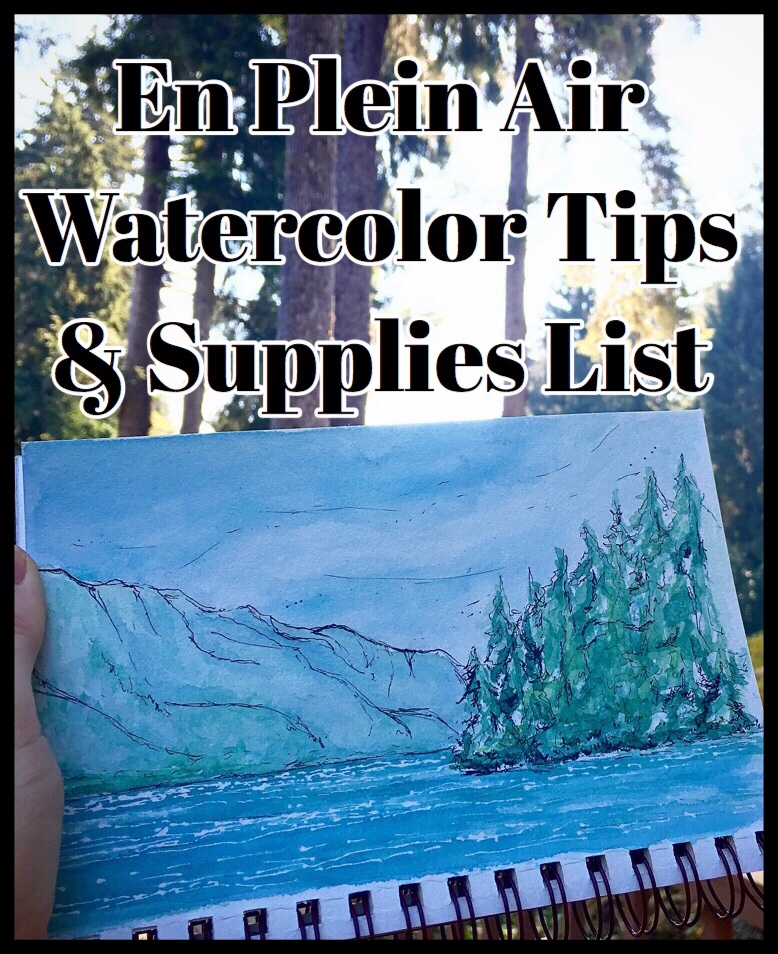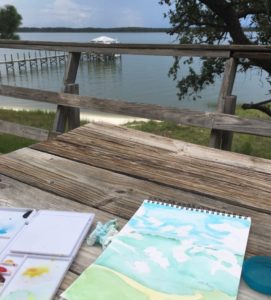 I’ll admit, I was intimidated by painting outside at first. The unpredictability of weather conditions, changing wind, insects, all the bits of chaos that come with leaving a climate controlled space are unnerving for someone who strives for control in their art.
I’ll admit, I was intimidated by painting outside at first. The unpredictability of weather conditions, changing wind, insects, all the bits of chaos that come with leaving a climate controlled space are unnerving for someone who strives for control in their art.
But these bits of chaos can also contribute to the life of the piece, add their own richness. I find that the lack of control has also allowed me more freedom in my art, more playfulness. Plus there are all the added benefits of being out in real sunlight, watching the way shadows move on a landscape, seeing how colors change as the sun travels through the sky.
Even if I am not looking at the scene that I am painting, for instance finishing something I started at a different location or painting from a photograph, I enjoy combining two of my favorite things- painting and being outside.
Last winter, eager to expand my understanding of watercolor techniques (and also searching for an excuse to travel across the country with a bestie) I attended a watercolor retreat at the base of Mount Hood with a group of incredible women. It was on this trip that my love of painting outside really materialized.
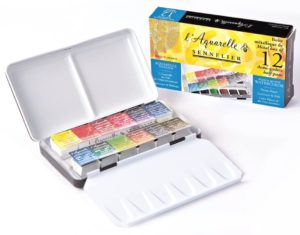 I have created, and recreated, a portable watercolor kit since then. I have found things that work better for me by playing around a bit, so maybe I can help you take some of the guesswork out of it.
I have created, and recreated, a portable watercolor kit since then. I have found things that work better for me by playing around a bit, so maybe I can help you take some of the guesswork out of it.
I love the colors in this curated Sennelier paint set. The blues do not bloom as much as some other brands I have bought. The colors are clean and smooth, and the set is small and convenient to carry around anywhere. I have since switched over to tubed paints and use a mix of manufacturers for different colors depending on what I like. Because although I love clean, smooth blues, sometimes I actually want my blues to bloom! It can add another layer of unpredictability and fun to a piece.
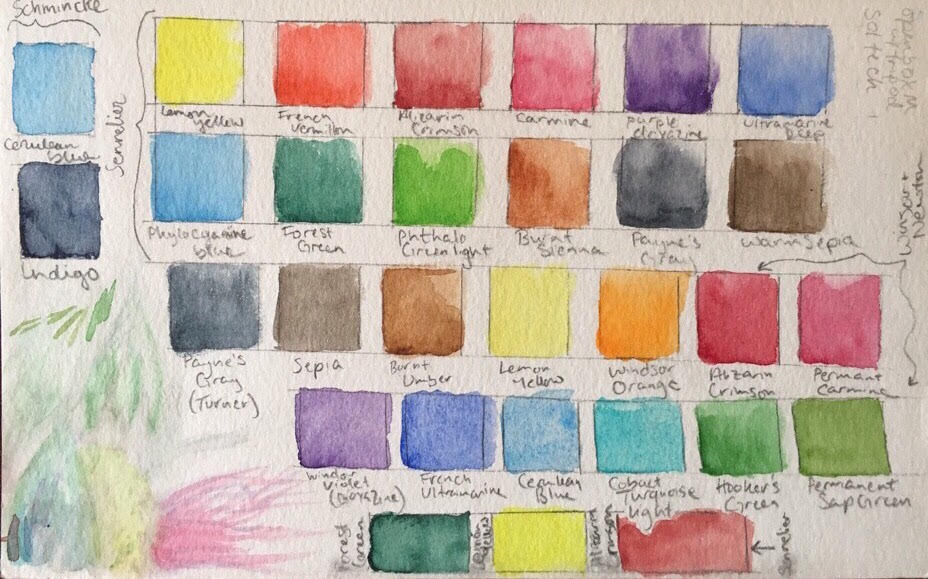 So, I like tubed paints because I can have paints from Sennelier, Winsor & Newton, Turner and Schminke, all of which I do have and use regularly. Paynes gray from Turner is a little more blue than Paynes gray from Sennelier. And Alizarin Crimson from Sennelier is a little more red than that from Winsor & Newton.
So, I like tubed paints because I can have paints from Sennelier, Winsor & Newton, Turner and Schminke, all of which I do have and use regularly. Paynes gray from Turner is a little more blue than Paynes gray from Sennelier. And Alizarin Crimson from Sennelier is a little more red than that from Winsor & Newton.
The colors available on Amazon are inconsistent and often out of stock, and each art store has its own preferred brands that they sell, so I do not want to focus on providing you an exhaustive list of links and colors you should own. Search any of the brands I mentioned and see what deals come up, go to your local arts & crafts store, and if you have any brands that you love and I did not mention, please comment below, because I am always down for trying more.
The best thing to do is just start playing around! It also greatly depends on what you want to paint. There are many colors in my palette that I go to when working on a botanical illustration but hardly touch when painting a landscape. Your palette does not have to look like mine. There are no rules. It is a good idea to make a cheat sheet with all your colors though, because they never look on paper like they do in the tray.
Once you have the paints, you need a palette to store and mix them. These porcelain palettes are nice, because they do not stain, and they should last you a lifetime, but they are noisy and a little heavier to carry around. I started with the porcelain and while I love the idea of it, I now primarily use this plastic palette which has proven to be lighter while offering a larger mixing area.
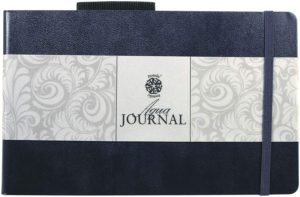 I do not leave home without my Moleskine pocket size watercolor notebook. I love the compact size (3.5″ x 5.5″) which leaves me no excuse to not have it on me at all times. For a recent trip to the Olympic Peninsula, I decided to upgrade to this Pentalic Aqua Journal in the next size up (5″ x 8″) with a built in loop for a pen or pencil. Sadly, it does not fit my mechanical pencil, which I like to carry mostly for its eraser and the fact that I do not have to also carry a sharpener. It is basically my “emergency pencil” and good for jotting down quick notes, but I usually also have an HB or 2H pencil on me as well as some waterproof pens. If you do not have a nice set of pens and pencils, invest in those as well. This is a good graphite pencil set and I like these pens because they do not bleed under the watercolor.
I do not leave home without my Moleskine pocket size watercolor notebook. I love the compact size (3.5″ x 5.5″) which leaves me no excuse to not have it on me at all times. For a recent trip to the Olympic Peninsula, I decided to upgrade to this Pentalic Aqua Journal in the next size up (5″ x 8″) with a built in loop for a pen or pencil. Sadly, it does not fit my mechanical pencil, which I like to carry mostly for its eraser and the fact that I do not have to also carry a sharpener. It is basically my “emergency pencil” and good for jotting down quick notes, but I usually also have an HB or 2H pencil on me as well as some waterproof pens. If you do not have a nice set of pens and pencils, invest in those as well. This is a good graphite pencil set and I like these pens because they do not bleed under the watercolor.
If you prefer a notebook that you can easily tear pages out of, try this Strathmore Visual Journal, great for travel, or this Arches Watercolor Paper Pad which helps prevent warping that can occur when you begin to saturate your paper.
If you want to use Ox Gall in your water, which helps eliminate blooming, you will need something to get it out of the bottle without spilling it. I like these bottles which are made for use with essential oils, and also make for pretty good water vessels as long as you are working on something small. If you need more water, any plastic, glass or metal jar will work and you likely already have something around the house. You will want something with a lid so you can practice leave no trace principles and pack out your dirty water. Some pigments are made from heavy metals and should not be discarded straight out into the environment.
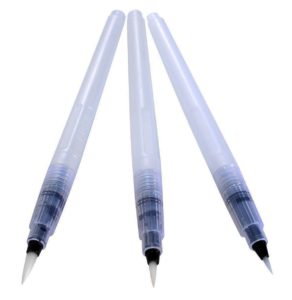 You can also skip the Ox Gall, and the jar for that matter and use these brushes with the water resevoir built in! Bonus points that they eliminate any dirty water to pack out with you. These things do take a little getting used to though. You squeeze the brush to release water, but it is hard to do it with very much control. I usually squeeze a little out onto my palette, and not as often directly on the paper. Keep a paper towel in your kit for cleaning the brush between colors and for blotting your page when you need to take a little off a heavy layer of paint.
You can also skip the Ox Gall, and the jar for that matter and use these brushes with the water resevoir built in! Bonus points that they eliminate any dirty water to pack out with you. These things do take a little getting used to though. You squeeze the brush to release water, but it is hard to do it with very much control. I usually squeeze a little out onto my palette, and not as often directly on the paper. Keep a paper towel in your kit for cleaning the brush between colors and for blotting your page when you need to take a little off a heavy layer of paint.
While I find myself gravitating to these water-built-in brushes lately for quick outdoor sketches, I do like a good brush. I use this #00 Winsor & Newton sable brush a lot in my botanicals, and the smaller sizes are quite affordable, but the bigger ones get expensive fast! I have a hodge-podge of brushes in a variety of sizes, shapes, and brands, but for my outdoor watercolors, I like these three best: 00 Winsor & Newton Series 7 Sable, 4 Ebony Splendor 387 Synthetic, and 8 Silver Black Velvet 3000S Natural/Synthetic Blend.
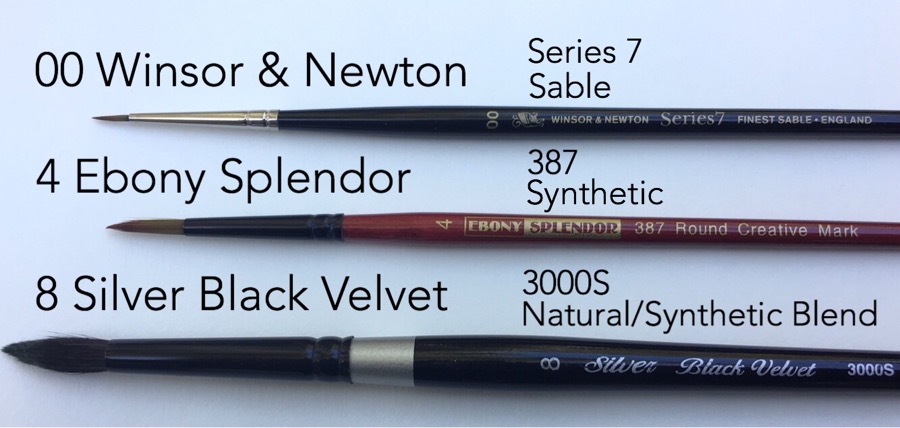
I am on the hunt for an affordable giant brush though, so if any one has recommendations, comment below!
Though not necessary, it doesn’t hurt to have some masking fluid on you too. Masking fluid can be used on clean paper or between layers of watercolor in areas where you do not want the watercolor to penetrate. Great for starry night skies, I also used it on my recent trip to preserve bright white reflections in the water at Crescent Lake.

I like this bottle because it has a very fine nozzle, giving you more control than the pen style, but you need to make sure to store it properly, with the pin inserted into the nozzle to keep it from drying out.
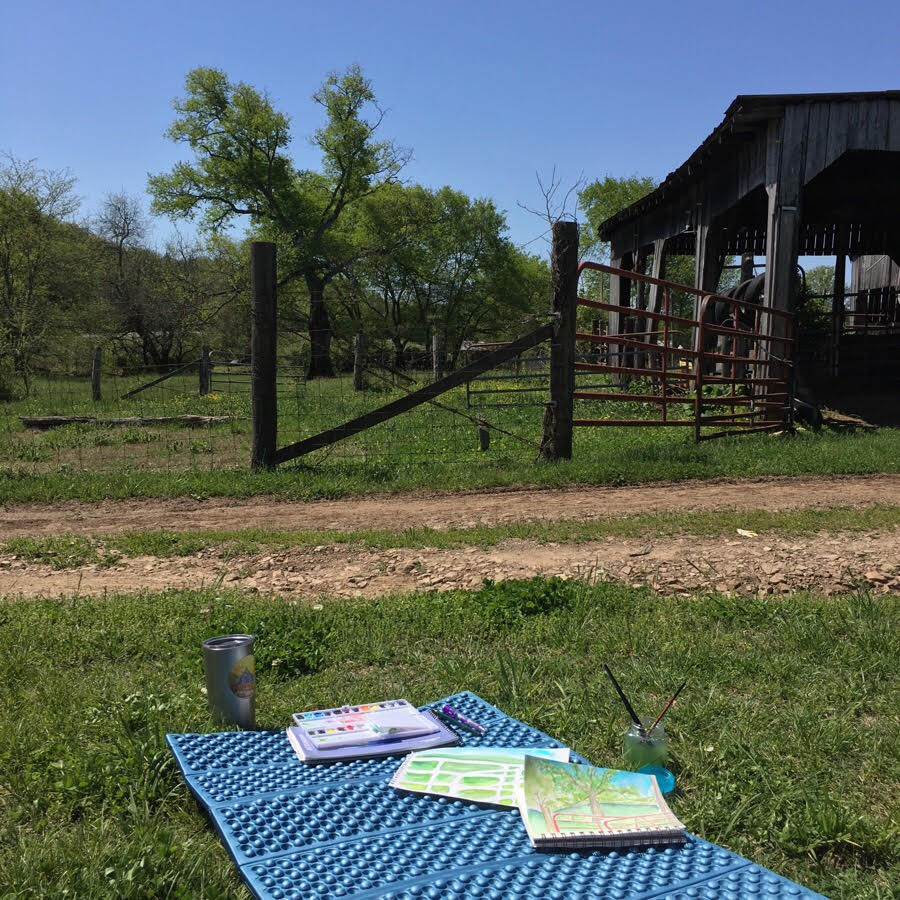 All that is left is something to carry it all in and something to sit on. I use the smallest pouch I have that will fit my paints, and then I usually have a tote to carry my paint pouch, paper, seat, and any snacks or water I might want with me.
All that is left is something to carry it all in and something to sit on. I use the smallest pouch I have that will fit my paints, and then I usually have a tote to carry my paint pouch, paper, seat, and any snacks or water I might want with me.
As far as the pouch goes, it is hard for me to make a recommendation since it depends greatly on which pieces you have decided to put together from this list. It is not a “one size fits all” endeavor. I suggest you gather all the pieces and see how big of a bag you will require and then see what you have on hand. I use a pouch that I have had as long as I can recall and I presume was made for carrying makeup.
For a seat, if I even have one with me, I usually use this Field & Stream Camp Pad which works great because it is big enough I can stretch out and change positions often, although at times the larger size can be a bit cumbersome. I am just as likely to be standing or sitting on a tree stump, at a picnic table, or just right on the ground, but there are times when a proper seat is nice to have. Just get out there with whatever will make you most comfortable.
So, now you know what I like to have in my en plein air watercolor kit and why. You know what I like and what I like better. I listed multiple options in a lot of cases because there is no wrong answer! I wish simply to help guide you in this journey; don’t be afraid to deviate. And if you do deviate or have something in your kit that I missed, please share your tips with me. Most of all I encourage you to jump right in and give it a try, and I hope you find painting outdoors to be as inspiring as I do.
Like it? Subscribe!

